West Ham's biggest strength? Allardyce's tactical flexibility
Greg Lea assesses the tactical progress made by Sam Allardyce's West Ham United this season...

“All this tippy-tappy stuff – everybody keeps going on about the right way to play football – it's all a load of b*llocks”, Sam Allardyce said forthrightly after his West Ham side defeated Hull City in the Premier League two weeks ago.
“Getting the ball into the box quickly with quality is the best way forward sometimes. That’s what we did in the second half [and] that’s why we won”.
The marriage between Allardyce and the Irons has always felt like one of convenience. When the then-56-year-old took the reins in June 2011, West Ham had just been relegated to the Championship and Allardyce had been out of work since his sacking by Blackburn six months previously. The arrangement suited both parties.
After winning promotion at the first attempt and consolidating back in the Premier League over the next two seasons, the former Bolton manager met all objectives in terms of league position in his first three campaigns.
Nevertheless, Allardyce has never been warmly received by West Ham followers, who perceive his methods as at odds with the somewhat indeterminate ‘West Ham way’.
The board attempted to assuage the strained relationship – which reached its lowest ever point midway through 2013/14 – by ordering the introduction of a more attacking approach last summer but, despite an excellent first half of the season that sees the club sit ahead of Saturday’s opponents Liverpool in seventh place in the table, the accord continues to appear uneasy.
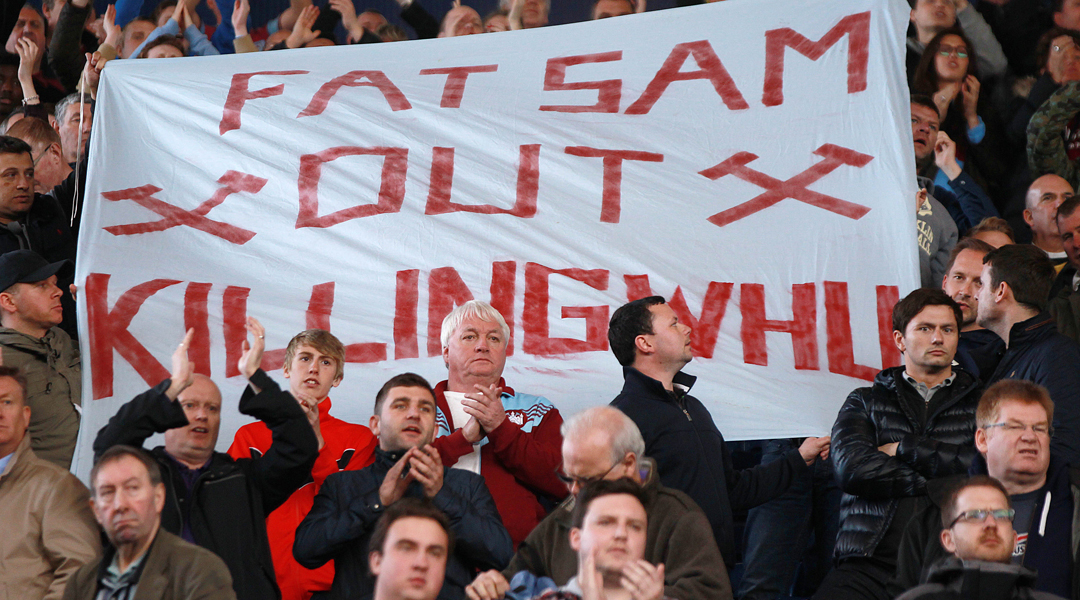
At times during the win over Hull, the discontent that was almost ever-present last year returned to Upton Park, a reaction that seemed to bring about Allardyce’s post-match comments on West Ham’s style.
Get FourFourTwo Newsletter
The best features, fun and footballing quizzes, straight to your inbox every week.
Results have remained consistent but the team have been noticeably more direct since Andy Carroll returned from injury in November, and it will be interesting to see if the Hammers’ supporters are prepared to forgive further deviations from their stylistic ideal if their side continues to challenge for Europe.
Results-wise, the beginning of this term was mixed for West Ham; a comfortable 3-1 victory over Crystal Palace sandwiched between defeats to Tottenham and Southampton.
Even in those initial fixtures, though, a slight change in style could be detected: there was a discernible effort to make short passes and build-up play patiently at Selhurst Park, with West Ham circulating the ball well and registering 54.3% possession.
The game’s most common pass combinations were James Tomkins to Mark Noble, Noble to Mauro Zarate and Joey O’Brien to Stewart Downing , suggesting a clear desire to play through the midfield.
This was again evident in the draw at Hull in September and October’s win over QPR. In the former, West Ham completed 80.9% of their passes, of which only 9.3% were long.
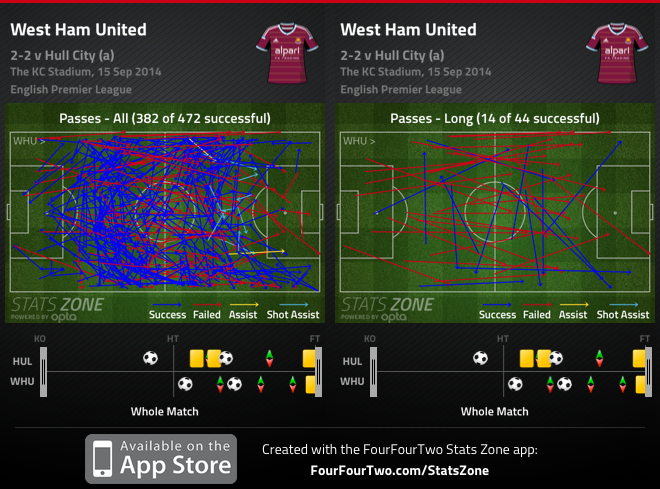
Against QPR, meanwhile, 31.1% of West Ham’s total attempted passes were backwards, a relatively large total that suggests increased patience in their play.
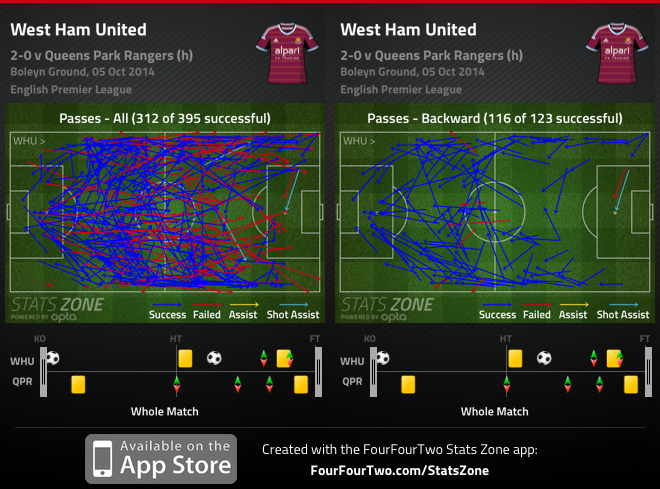
It is troublesome, however, to attribute the early tweaks purely to boardroom and fan pressure. Teddy Sheringham was employed as an attacking coach in the summer as a compromise of sorts but, while the former England striker presumably has lots to offer in terms of teaching one-on-one striking technique, it is unlikely that he has any significant influence on the team’s overriding strategy.
West Ham’s methodological alteration was more likely down to classic Allardyce pragmatism. With Alex Song – who is far more than just a midfield destroyer – arriving from Barcelona, Allardyce likely calculated that it made sense to utilise him as a deep-lying playmaker and give him the responsibility to build the team’s attacks from deep. In the November draw with Aston Villa – a game which saw West Ham have 58.2% possession – no player completed (53) or attempted (69) more passes than Song.
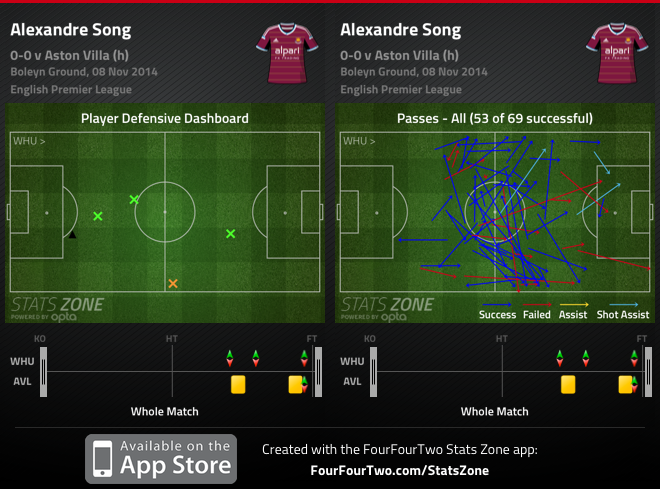
Indeed, the slightly more patient West Ham was probably down to the players now available rather than a drastic transformation in Allardyce’s philosophy. As well as Song, internationals Diafra Sakho, Enner Valencia and Cheikhou Kouyate were added in the summer, so too the more peripheral but undeniably technical Morgan Amalfitano and Mauro Zarate.
With a better quality of footballer in the ranks, it made sense for Allardyce to promote a more measured, possession-based game. This likely induced the decision to employ a diamond formation, a setup that minimises attacking width and is conducive to playing through the centre of the pitch.
Since Andy Carroll returned from injury, though, West Ham have become more direct. In the defeat of Newcastle in late November – Carroll’s second start of the campaign – the Hammers’ most repeated passing combination was between goalkeeper Adrian and the 6ft 4in centre-forward. That situation reoccurred in the home encounter with Swansea a week later; Carroll scored two headers from crosses that afternoon, winning the same number of aerial duels (15) as the entire Swansea team.
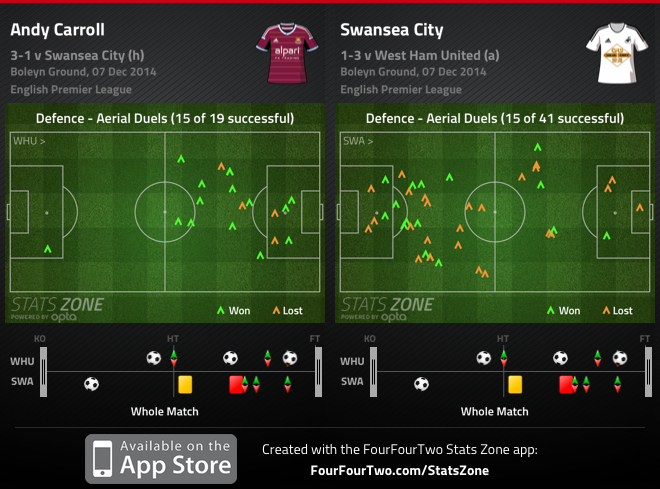
It was a similar story against Leicester shortly before Christmas: the early-season patient build-up appeared to have given way to a quicker, more direct method of play, with West Ham completing just 72.1% of their passes, a figure that indicates they were playing longer, riskier balls.
A look at the number of overall passes completed in games is also noteworthy. When Sakho and Valencia were paired up front to face Hull in September and Villa in November, the Hammers made 382 and 325 passes.
With Carroll leading the line against Newcastle and Leicester, Allardyce’s charges completed just 264 and 248 respectively. The focus had shifted as West Ham hit the ball forward longer and quicker, with the club’s average pass success rate since dropping to the fifth-lowest in the division.
It remains unclear which approach Allardyce will lean towards going forward, although it is erroneous to view it as a binary choice between patient short passing à la Vicente del Bosque’s Spain and the kick and rush made famous by the Wimbledon of the 1980s.
It would be imprudent not to make use of Carroll’s outstanding aerial ability by occasionally hitting long diagonals and crosses from deep, but that does not mean it has to become West Ham’s only method of attack.
Indeed, direct football is not always rudimentary hoofing to an isolated frontman: in the second half of last weekend’s match against Hull, West Ham moved the ball forwards quicker but still played through Downing at the tip of the diamond, the converted winger registering the most passes, shots, take-ons and chances created.
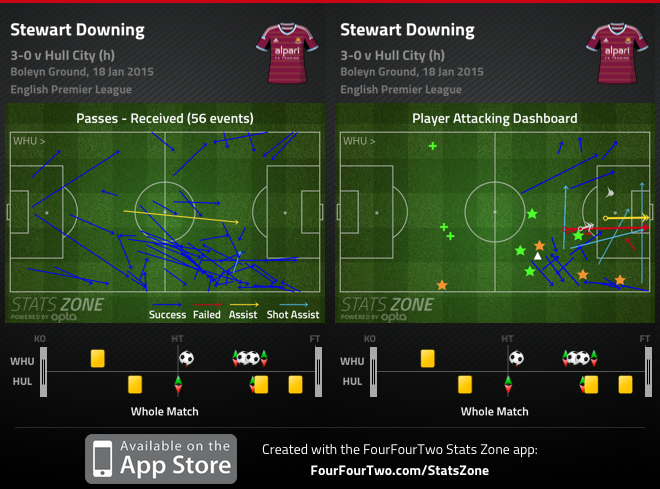
Directness, moreover, is not necessarily negative or less attractive; on the contrary, seeking to reach the opponent’s goal in as little time as possible can make for a thrilling, exhilarating spectacle.
Allardyce does not just accept he is a reactive manager, he revels in it: Roberto Martinez, Brendan Rodgers and Arsene Wenger have all been unfavourably compared to Allardyce by the man himself, who has suggested that his rivals’ we-stick-to-our-principles dogmatism is a negative trait compared to his own tactical flexibility.
It is certainly conceivable, then, that West Ham won’t have an easily-defined, consistent style for the remainder of the campaign but will adapt game by game. Nevertheless, Allardyce’s favoured plan – even before his tenure at Upton Park with Bolton, Newcastle and Blackburn – has been to get the ball forward quickly.
West Ham fans may have been singing “Barcelona, we’re coming for you” this year, but it is unlikely that their manager will ever fully embrace the ‘tippy-tappy’ game.
Liverpool vs West Ham LIVE ANALYSIS with Stats Zone
Greg Lea is a freelance football journalist who's filled in wherever FourFourTwo needs him since 2014. He became a Crystal Palace fan after watching a 1-0 loss to Port Vale in 1998, and once got on the scoresheet in a primary school game against Wilfried Zaha's Whitehorse Manor (an own goal in an 8-0 defeat).

